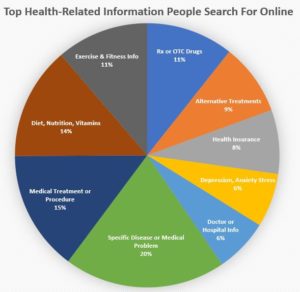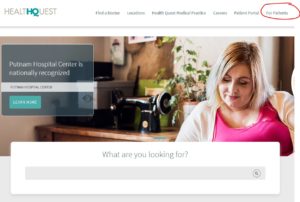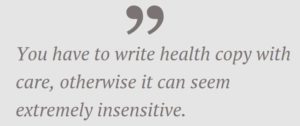Finding health care information online is becoming a ubiquitous past time for most of us. A recent study by the Pew Internet & American Life project revealed that over ninety million Americans have searched for a health-related topic online.
We search for many different types of health information, from researching a specific physician or hospital to trying to understand the pros and cons of vaccines. Of the sixteen topics listed in the Pew survey, here’s a breakdown of the kind of information people are seeking out online—information that health care professionals are increasingly expected to provide.
Data Source: Pew Internet & American Life
Health care providers have more opportunities than ever before to educate current and prospective patients in a way that is engaging and informative. But providing health care information on a website or elsewhere, such as social media, can be challenging.
I spoke with our resident expert, Phillippa Ewing, about the importance of humanizing health care content so that it’s accessible to patients.
“Patients want to understand what you say,” Says Phillippa, Ashworth Creative’s Lead Marketing Strategist. “The content on your website shouldn’t be presented as a barrier for patients seeking information.”
With this in mind, we’ve compiled five best practices based on more than twenty-five years of experience in writing health content for a variety of health care clients across multiple channels including print, digital, radio, TV and out of home.
-
Write for the right audience
Content that’s accessible to patients isn’t necessarily appropriate for physicians. Health care providers should be aware that multiple constituents (e.g., patients, physicians, insurance companies, etc.) are visiting their website and it’s not possible to address all of them with one piece of content.
“Your audience is more than one person,” Phillippa says, “This is a dilemma for health care provider websites because sometimes they’re at odds with each other. Sometimes a physician is looking to substantiate a provider that they want to refer their patient to, so patient-centered content isn’t technical enough.”
The best way to address the issue of multiple audiences is to provide content for all types of potential visitors. You can label each piece of content accordingly (e.g., this article is intended for physicians). Providers can also bucket the content on their website into sections that clearly target various constituents (e.g, For Patients).
As shown in the screenshot, above—our client, HealthQuest, has a separate section on their website which is clearly labeled “For Patients.”
-
Talk to people, not at them
“Patients want to understand what you say,” says Phillippa. But this can be difficult with something as complex as health information, particularly when there is a lot of medical jargon and complex terminology associated with a condition, treatment or disease.
One way to humanize complex content is to address the reader directly. “Say ‘you’ and not ‘the patient,’ recommends Phillippa. For example, you could write, “If you have a movement disorder such as Parkinson’s Disease” instead of, “If the patient has a movement disorder such as Parkinson’s Disease.”
Depending on the target reader, you may need to adjust your writing level. For patients, that means writing at a 4th or 5th grade level. “But it’s important not to talk down to people,” Phillippa says. Content should be easy to read and understand, but not cloying or patronizing. For a good example of cloying and/or patronizing content, watch just about any pharmaceutical ad.
Phillippa also recommends that providers avoid repeating hard-to-read terms in the text of a website. “differentiate copy so that it’s not repetitive.” says Phillippa. “Eliminate specialized names which are very hard to read.”
-
Remember, you are a human talking to another human
The best way to humanize content is to write from a place of empathy. Most of us have experience with a medical concern or crisis (either firsthand or via a family member). “An aspect of effective healthcare writing is the ability to be empathetic and trigger or respond to emotions,” says Phillippa.
“People on health care websites are often in a crisis or stressed. Writing with empathy and appealing to emotions is good. Being cold and remote, is not.”
When you write with your own firsthand experience in mind, your content immediately becomes more relatable and empathic.
Says Phillippa, “Drawing from your own firsthand experience helps you express complex medical issues in human terms.”
-
Avoid Recycled Content
“Recycled writing isn’t readable and reflects poorly on the practice,” Says Phillippa. “You have to write health copy with care, otherwise it can seem extremely insensitive. You also don’t want to scare people. Health care professionals have a responsibility not to mislead their patients or put them off getting help when they need it.”
Even so, the lure of poorly written or recycled content has never been stronger. Content mills—companies that employ large numbers of writers for the sole purpose of producing fast, low-quality content—abound.
Content Mills don’t pay their writers a living wage, pump out large volumes of content, have poor quality control and tend to employ inexperienced writers. Churn rate is high as writers burn out and leave for better paying jobs.
The best way to make sure that you get high quality content is to work with writers who have experience in the healthcare industry and understand the nuances involved in presenting complex topics in an easy to read format.
Says Phillippa, “It’s important to work with writers that have experience with healthcare or you’re just going to Google and regurgitate someone else’s content. It’s too great a risk for the health care provider to take.”
-
Be mindful of the demographic you’re writing for
Your patients may talk about their health using different terminology than you do. It’s important to keep this in mind when creating content on your website that resonates with them.
Some conditions are more prevalent in certain demographics than others. For example, colon cancer and diabetes are both conditions that disproportionately affect certain populations.
“A patient with diabetes may refer to the condition as ‘having trouble with my sugar’,” Phillippa points out. “You have to couch the information to this patient population in language that they actually use. Knowing the colloquial way that people refer to their illness or condition is very important.”
Conclusion
With health care companies geared up to spend more than $1 Billion online within the next 5 years, it’s more important to your practice than ever to create high quality content that adequately answers patients’ questions.




